60-Second Summary
Modernizing your ECM workflows with advanced technologies not only cuts costs but also boosts productivity and competitiveness. Embrace change management strategies to smoothly transition and fully realize the benefits of upgraded document management systems. Invest in efficiency today for substantial cost savings and improved operational performance.
ECM Workflows: Why Upgrading Your Document Preparation and Scanning Operations is Crucial
In the age of digital transformation, businesses are increasingly relying on document automation to streamline their operations. However, many organizations still struggle with outdated and inefficient document preparation, scanning, and post-scan processes. The cost of not improving these operations can be substantial, both in terms of money and productivity. This blog will explore the typical workflow, the number of employees required, and the financial impact of maintaining the status quo.
The Traditional Workflow: A Labor-Intensive Process
Document Preparation
The first step in the document scanning process is preparation. This involves removing staples, paper clips, and any other bindings, as well as sorting and arranging documents. Typically, a team of employees is dedicated to this task, which can be both time-consuming and labor-intensive. Depending on the volume of documents, this stage can require several full-time employees, adding to your operational costs.
Scanning
Once the documents are prepared, they are fed into scanners. This stage often requires one or more employees to monitor the scanners, troubleshoot issues, and ensure that documents are scanned correctly. High-volume scanning operations might require multiple scanners, each requiring an operator.
Post-Scan Quality Control (QC)
After scanning, the images are reviewed for quality control. This involves checking for missing pages, poor image quality, and other issues that might require rescanning. This stage can also demand significant manpower, as each document may need to be carefully examined.
It's not the speed of the scanner - It's the amount of prep!
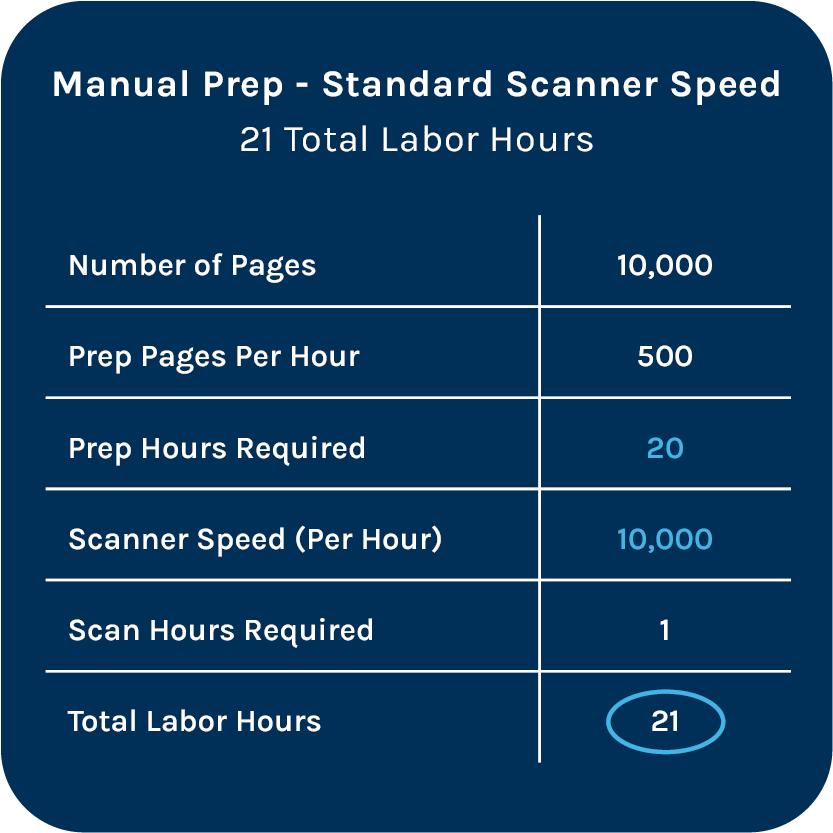
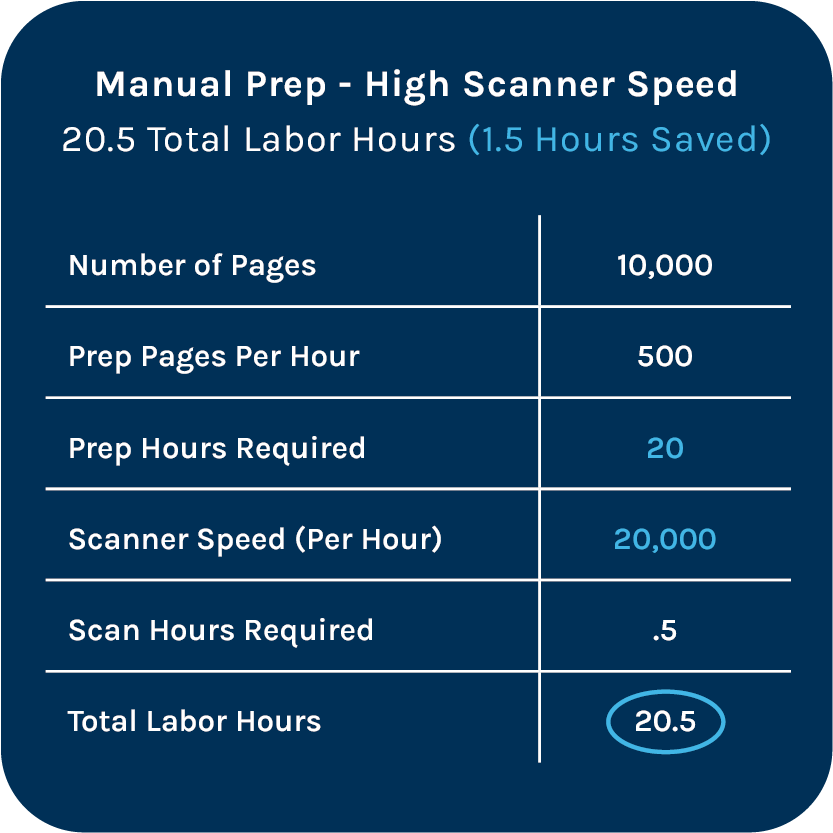
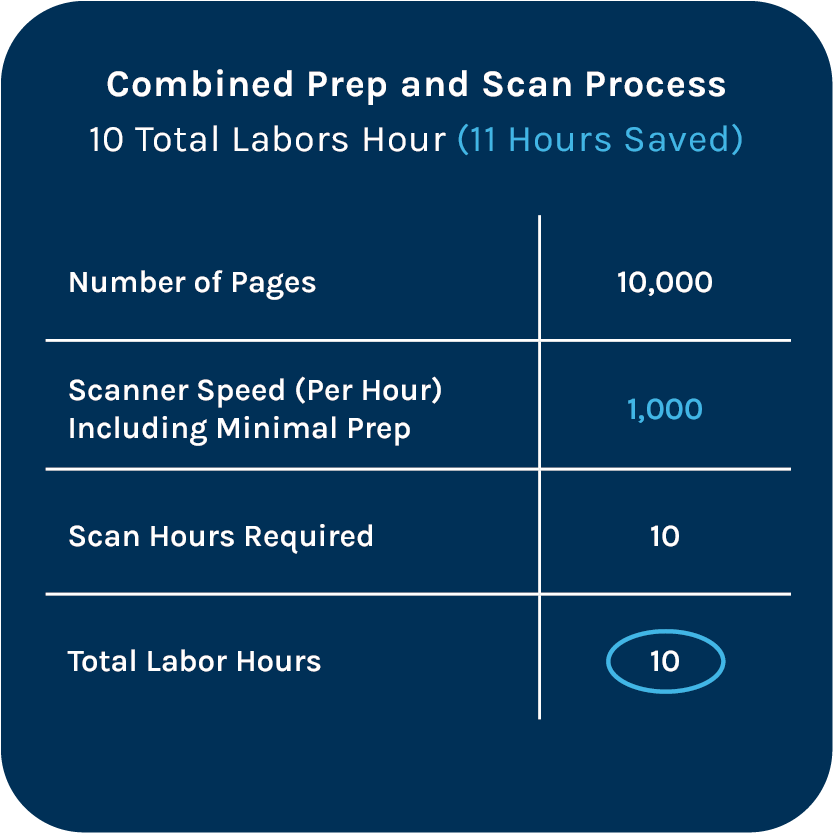
The High Cost of ECM Inefficiencies
Maintaining a traditional document scanning workflow can be expensive. Here are some of the hidden costs:
Labor Costs
The need for multiple employees at each stage of the process results in high labor costs. These labor-intensive tasks can significantly inflate your operational expenses.
Time
Inefficient processes take longer to complete, leading to delays and decreased productivity. Time spent on document preparation, scanning, and post-scan QC could be better utilized for more value-added activities.
Errors and Rework
Opportunity Cost
Resources tied up in inefficient processes could be redirected toward more strategic initiatives that drive business growth.
The Solution: Adopting a "One-Touch" open and scan process
The “One-touch” approach has transformed document scanning, significantly reducing the time and labor required for document preparation and post-scan QC.
The “One-Touch” Process
The open and scan process streamlines document preparation by allowing mixed document types and sizes to be fed directly into the scanner without extensive pre-sorting, with only the removal of staples and paper clips. This innovative approach minimizes the need for manual intervention, reducing the number of employees required for preparation and significantly speeding up the process.
CertainScan Intelligent Document Imaging Software
CertainScan, OPEX’s proprietary software, can insert virtual batch headers, separator sheets, toggle sheets, capture metadata, create file names, and much more. It is also a powerful post-scan QC tool that automates the quality control process. It intelligently detects and corrects errors, such as skewed images or missing pages, reducing the need for manual review. This not only speeds up the QC process but also ensures higher accuracy and fewer rescans.
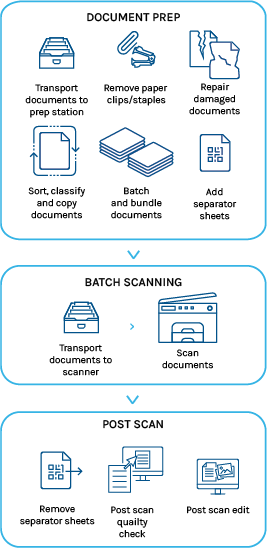
Traditional Document Prep and Scanning
Traditional Document Prep and Scanning of mixed documents requires multiple preparation steps and transfers from station to station. The prep is highly manual and tedious, consuming valuable time and resources. When items are transferred to different stations, documents may become disassociated or lost from folders or boxes, while potentially exposing sensitive data on the documents.
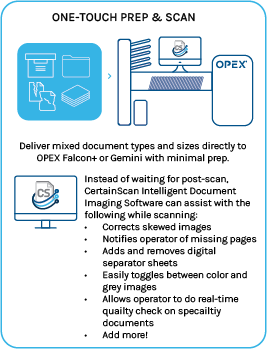
ONE-TOUCH PREP & SCAN
By eliminating non-value-added steps, the One-Touch process significantly decreases reliance on labor, increases workflow efficiency, and improves job security and accuracy. This translates to substantial cost savings and a quick return on investment.
The Benefits of Upgrading to a One-Touch Scan Process
Reduced Labor Costs
Increased Efficiency
Faster preparation and scanning times mean documents are processed more quickly, leading to improved productivity.
Improved Accuracy
Automated QC processes reduce the likelihood of errors, ensuring higher quality scans and fewer rescans.
Cost Savings
Overall, the efficiencies gained from upgrading to the “One-Touch” process with intelligent scanning technology translates to substantial cost savings, making the investment worthwhile.
The Importance of Change Management
Implementing new technology and processes can be daunting, but the benefits of upgrading your document management system far outweigh the challenges. A well-executed change management strategy can significantly enhance the success of technology implementations. By carefully planning and managing the transition, businesses can mitigate risks and ensure a smoother adoption process.
Moving from traditional scanning methods to the OPEX One-Touch process requires re-engineer workflows, retrain staff, and, most importantly, gain buy-in from everyone involved. We have seen customers go through this transition and experience the benefits of increased efficiency and cost savings, which provide a significant return on investment. The OPEX team will work closely with you, offering a financial analysis that clearly demonstrates the bottom-line benefits.
The Financial Perspective
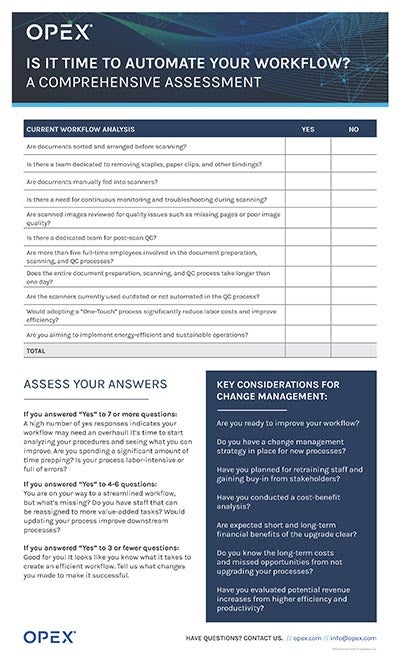
Is it time to automate your workflow?
Conclusion
Other Resources You Might Find Helpful
NHS Business Services Authority: Rapidly Expanding Patient List Drives Opportunity to Digitize Medical Records
Legastat: When Flatbed Scanning is NOT Enough
Konica Minolta’s Competitive Edge: Streamlining Document Workflows with OPEX® Technology
SPS and OPEX® Falcon+® RED® Document Scanners Provide Digitization at Sanitas
Built for Compliance: How Modern Scanning Systems Deliver Operational Excellence
Seamless Integration and Future Ready Automation with AI
What is Right-Speed Scanning?
Swiss Post Solutions Delivers Innovation and Automation to Clients Leveraging The OPEX Falcon+® RED™
Leon County Supervisor of Elections Overhauls Its Manual Document Process, Saving Money for Taxpayers
GTL Implements Automation & AI to Transform the Claims Handling Process
NEXT LEVEL AUTOMATION
Unlock Operational Efficiency with OPEX
OPEX is powering the future of automation. Contact us to learn more about how our vertically integrated automated solutions can help take your business to new heights.